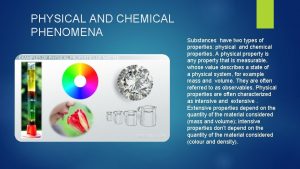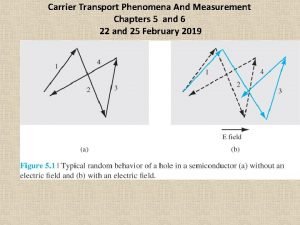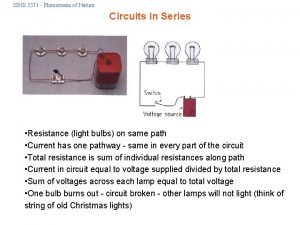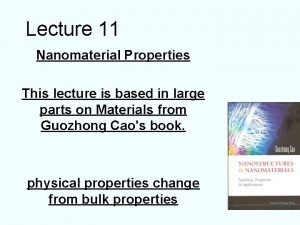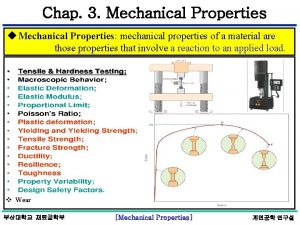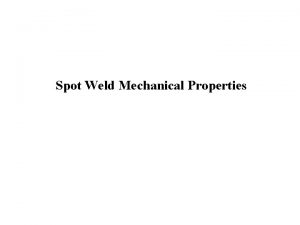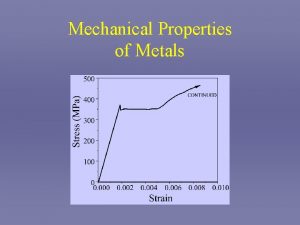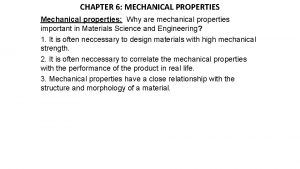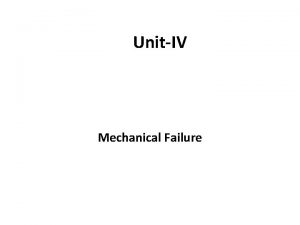Mechanical Properties Phenomena related to mechanical properties Fundamentals
















![Linear Elasticity • Modulus of Elasticity, E: Units: E [GPa] or [psi] (also known Linear Elasticity • Modulus of Elasticity, E: Units: E [GPa] or [psi] (also known](https://slidetodoc.com/presentation_image/6915dcac25b6b71eacf09f1d6f68bf6e/image-17.jpg)














- Slides: 31

Mechanical Properties Phenomena related to mechanical properties Fundamentals of Materials Science 1

Mechanical Properties Why mechanical properties? • Need to design materials that will withstand applied load and in-service uses for… Bridges for autos and people MEMS devices skyscrapers Space exploration Fundamentals of Materials Science Space elevator? 2

Mechanical Properties Objectives • Define Stress and strain: Normalized force and displacements. • Define Elastic constants: Ability to be deformed elastically. • Understand Elastic behavior: When loads are small. • Understand Plastic behavior: dislocations and deformation • Toughness, ductility, resilience, toughness, and hardness: Define and how do we measure? • Mechanical behavior of the various classes of materials. Fundamentals of Materials Science 3

Stress: Dilation Fundamentals of Materials Science

Shear deformation Fundamentals of Materials Science

Tensile stress Fundamentals of Materials Science

Shear stress Fundamentals of Materials Science

Stress and Strain Stress: Force per unit area arising from applied load. Tension, compression, shear, torsion or any combination. Stress = σ = force/area Strain: ε – physical deformation response of a material to stress, e. g. , elongation. Fundamentals of Materials Science 8

Pure Tension Pure Compression stress strain Elastic response stress Pure Shear strain Elastic response Pure Torsional Shear Fundamentals of Materials Science 9

Common States of Stress • Simple tension: cable • Simple shear: drive shaft Ski lift (photo courtesy P. M. Anderson) Note: t = M/Ac. R here. Fundamentals of Materials Science 10

Common States of Stress • Simple compression: (photo courtesy P. M. Anderson) Note: compressive structural member (σ < 0). (photo courtesy P. M. Anderson) Fundamentals of Materials Science 11

Common States of Stress • Bi-axial tension: • Hydrostatic compression: (photo courtesy P. M. Anderson) Pressurized tank (photo courtesy P. M. Anderson) σh < 0 Fundamentals of Materials Science 12

Engineering Strain • Tensile strain: • Lateral (width) strain: • Shear strain: Strain is always dimensionless. Fundamentals of Materials Science 13

Elastic Deformation 1. Initial 2. Small load 3. Unload bonds stretch return to initial d F F Linearelastic Elastic means reversible! d Fundamentals of Materials Science Non-Linearelastic 14

Plastic Deformation of Metals 1. Initial 2. Small load bonds stretch & planes shear 3. Unload planes still sheared δplastic δelastic + plastic F F Plastic means permanent! linear elastic δplastic εelastic Fundamentals of Materials Science d 15

Strain Testing • Tensile specimen • Tensile test machine Often 12. 8 mm x 60 mm Adapted from Fig. 7. 2, Callister & Rethwisch 3 e. extensometer specimen gauge length • Other types: -compression: brittle materials (e. g. , concrete) -torsion: cylindrical tubes, shafts. Fundamentals of Materials Science 16
![Linear Elasticity Modulus of Elasticity E Units E GPa or psi also known Linear Elasticity • Modulus of Elasticity, E: Units: E [GPa] or [psi] (also known](https://slidetodoc.com/presentation_image/6915dcac25b6b71eacf09f1d6f68bf6e/image-17.jpg)
Linear Elasticity • Modulus of Elasticity, E: Units: E [GPa] or [psi] (also known as Young's modulus) • Hooke's Law: σ = E ε s Axial strain E Linearelastic Fundamentals of Materials Science e Width strain 17

Example: Hooke’s Law • Hooke's Law: σ=Eε (linear elastic behavior) Copper sample (305 mm long) is pulled in tension with stress of 276 MPa. If deformation is elastic, what is elongation? For Cu (polycrystalline), E = 110 GPa. Axial strain Width strain Hooke’s law involves axial (parallel to applied tensile load) elastic deformation. Fundamentals of Materials Science 18

Comparison of Elastic Moduli Silicon (single xtal) 120 -190 (depends on crystallographic direction) Glass (pyrex) 70 Si. C (fused or sintered) 207 -483 Graphite (molded) ~12 High modulus C-fiber 400 Carbon Nanotubes ~1000 Normalize by density, 20 x steel wire. strength normalized by density is 56 x wire. Fundamentals of Materials Science 19

Young’s Modulus, E Metals Alloys Graphite Ceramics Polymers Semicond Composites /fibers E(GPa) Based on data in Table B 2, Callister 6 e. Composite data based on reinforced epoxy with 60 vol% of aligned carbon (CFRE), aramid (AFRE), or glass (GFRE) fibers. Fundamentals of Materials Science 20

Yield Stress, σY • Stress where noticeable plastic deformation occurs. When εp = 0. 002 For metals agreed upon 0. 2% tensile stress, σ σY P Elastic recovery • P is the proportional limit where deviation from linear behavior occurs. Strain off-set method for Yield Stress • Start at 0. 2% strain (for most metals). • Draw line parallel to elastic curve (slope of E). • σY is value of stress where dotted line crosses stress-strain curve (dashed line). Eng. strain, ε εp = 0. 002 Fundamentals of Materials Science Note: for 2 in. sample ε = 0. 002 = Δz/z Δz = 0. 004 in 21

Compare Yield Stress, σYS Room T values Based on data in Table B 4, Callister 6 e. a = annealed hr = hot rolled ag = aged cd = cold drawn cw = cold worked qt = quenched & tempered Fundamentals of Materials Science 22

(Ultimate) Tensile Strength, σTS • Maximum possible engineering stress in tension. TS F = fracture or ultimate strength engineering stress y Typical response of a metal strain engineering strain Neck – acts as stress concentrator • Metals: occurs when necking starts. • Ceramics: occurs when crack propagation starts. • Polymers: occurs when polymer backbones are aligned and about to break. Fundamentals of Materials Science 23

Compare Tensile Strength, σTS Metals/ Alloys Tensile strength, TS (MPa) 5000 3000 2000 1000 300 200 100 40 30 20 Graphite/ Ceramics/ Semicond Polymers Composites/ fibers C fibers Aramid fib E-glass fib Steel (4140) qt W (pure) Ti (5 Al-2. 5 Sn)aa Steel (4140)cw Cu (71500) hr Steel (1020) Al (6061) ag Ti (pure) a Ta (pure) Al (6061) a AFRE(|| fiber) GFRE(|| fiber) CFRE(|| fiber) Diamond Si nitride Al oxide Si crystal <100> Glass-soda Concrete Graphite Nylon 6, 6 PC PET PVC PP HDPE wood(|| fiber) GFRE( fiber) CFRE( fiber) AFRE( fiber) LDPE Based on data in Table B 4, Callister & Rethwisch 3 e. 10 wood ( 1 Room T values Fundamentals of Materials Science fiber) 24

Example for Metals: Determine E, YS, and TS Stress-Strain for Brass • Young’s Modulus, E (bond stretch) • 0 ffset Yield-Stress, YS (plastic deformation) • Max. Load from Tensile Strength TS • Gage is 250 mm (10 in) in length and 12. 8 mm (0. 505 in) in diameter. • Subject to tensile stress of 345 MPa (50 ksi) • Change in length at Point A, Δl = εl 0 = (0. 06)250 mm = 15 mm Fundamentals of Materials Science 25

Temperature matters (see Failure) Most metals are ductile at RT and above, but can become brittle at low T bcc Fe cup-and-cone fracture in Al Fundamentals of Materials Science brittle fracture in mild steel 26

Stress-Strain in Polymers brittle polymer plastic elastomer elastic moduli – less than for metals Adapted from Fig. 7. 22, Callister & Rethwisch 3 e. • Fracture strengths of polymers ~ 10% of those for metals. • Deformation strains for polymers > 1000%. – for most metals, deformation strains < 10%. Fundamentals of Materials Science 27

Hardness • Resistance to permanently indenting the surface. • Large hardness means: --resistance to plastic deformation or cracking in compression. --better wear properties. Adapted from Fig. 7. 18. Fundamentals of Materials Science 28

Hardness: Measurement • Rockwell – No major sample damage – Each scale runs to 130 (useful in range 20 -100). – Minor load 10 kg – Major load 60 (A), 100 (B) & 150 (C) kg • A = diamond, B = 1/16 in. ball, C = diamond • HB = Brinell Hardness – TS (psia) = 500 x HB – TS (MPa) = 3. 45 x HB Fundamentals of Materials Science 29

Hardness: Measurement Fundamentals of Materials Science 30

Summary • Stress and strain: These are size-independent measures of load and displacement, respectively. • Elastic behavior: This reversible behavior often shows a linear relation between stress and strain. To minimize deformation, select a material with a large elastic modulus (E or G). • Plastic behavior: This permanent deformation behavior occurs when the tensile (or compressive) uniaxial stress reaches sy. • Toughness: The energy needed to break a unit volume of material. • Ductility: The plastic strain at failure. Fundamentals of Materials Science 31
 Phenomena related to refraction
Phenomena related to refraction Two types of physical fitness
Two types of physical fitness Example of skill-related fitness
Example of skill-related fitness Passer-by monikko
Passer-by monikko Some natural phenomena ppt
Some natural phenomena ppt Physical and chemical phenomena
Physical and chemical phenomena Observable phenomenon
Observable phenomenon Contemporary phenomenon examples
Contemporary phenomenon examples Reference phenomena in nlp
Reference phenomena in nlp Reference phenomena in nlp
Reference phenomena in nlp Which are not purely surface phenomena
Which are not purely surface phenomena Gravitation is a natural phenomenon where:
Gravitation is a natural phenomenon where: Carrier transport phenomena
Carrier transport phenomena Anchor phenomena
Anchor phenomena Observable phenomena
Observable phenomena Importance of interfacial phenomena in pharmacy
Importance of interfacial phenomena in pharmacy Reoulox phenomena
Reoulox phenomena Global climate phenomena
Global climate phenomena Random phenomena
Random phenomena Phenomena vs noumena
Phenomena vs noumena Real life sinusoidal examples
Real life sinusoidal examples Brigitte falkenburg
Brigitte falkenburg Transport phenomena lecture notes ppt
Transport phenomena lecture notes ppt Noumena vs phenomena
Noumena vs phenomena Noumena vs phenomena
Noumena vs phenomena Critical angle
Critical angle Optical phenomena rainbow
Optical phenomena rainbow Noumena vs phenomena
Noumena vs phenomena Actual mechanical advantage vs ideal mechanical advantage
Actual mechanical advantage vs ideal mechanical advantage Ductility
Ductility Stress strain curve dental materials
Stress strain curve dental materials Mechanical properties of nano materials
Mechanical properties of nano materials





